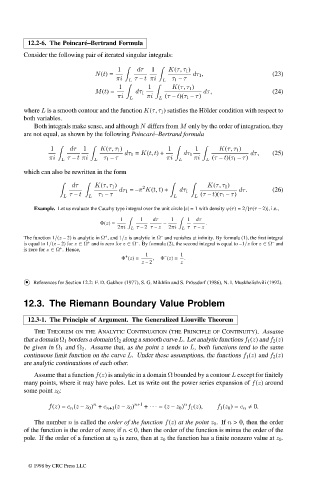Page 621 - Handbook Of Integral Equations
P. 621
12.2-6. The Poincar´ e–Bertrand Formula
Consider the following pair of iterated singular integrals:
1 dτ 1 K(τ, τ 1 )
N(t)= dτ 1 , (23)
πi L τ – t πi L τ 1 – τ
1 1 K(τ, τ 1 )
M(t)= dτ 1 dτ, (24)
πi L πi L (τ – t)(τ 1 – τ)
where L is a smooth contour and the function K(τ, τ 1 ) satisfies the H¨ older condition with respect to
both variables.
Both integrals make sense, and although N differs from M only by the order of integration, they
are not equal, as shown by the following Poincar´ e–Bertrand formula
1 dτ 1 K(τ, τ 1 ) 1 1 K(τ, τ 1 )
dτ 1 = K(t, t)+ dτ 1 dτ, (25)
πi L τ – t πi L τ 1 – τ πi L πi L (τ – t)(τ 1 – τ)
which can also be rewritten in the form
dτ K(τ, τ 1 ) 2 K(τ, τ 1 )
dτ 1 = –π K(t, t)+ dτ 1 dτ. (26)
τ – t τ 1 – τ (τ – t)(τ 1 – τ)
L L L L
Example. Let us evaluate the Cauchy type integral over the unit circle |z| = 1 with density ϕ(τ)=2/[τ(τ – 2)], i.e.,
1 1 dτ 1 1 dτ
Φ(z)= – .
2πi L τ – 2 τ – z 2πi L τ τ – z
+
–
The function 1/(z – 2) is analytic in Ω , and 1/z is analytic in Ω and vanishes at infinity. By formula (1), the first integral
+
–
–
is equal to 1/(z – 2) for z ∈ Ω and is zero for z ∈ Ω . By formula (2), the second integral is equal to –1/z for z ∈ Ω and
+
is zero for z ∈ Ω . Hence,
1 1
–
+
Φ (z)= , Φ (z)= .
z – 2 z
•
References for Section 12.2: F. D. Gakhov (1977), S. G. Mikhlin and S. Pr¨ ossdorf (1986), N. I. Muskhelishvili (1992).
12.3. The Riemann Boundary Value Problem
12.3-1. The Principle of Argument. The Generalized Liouville Theorem
THE THEOREM ON THE ANALYTIC CONTINUATION (THE PRINCIPLE OF CONTINUITY). Assume
that a domain Ω 1 borders a domain Ω 2 along a smooth curve L. Let analytic functions f 1 (z) and f 2 (z)
be given in Ω 1 and Ω 2 . Assume that, as the point z tends to L, both functions tend to the same
continuous limit function on the curve L. Under these assumptions, the functions f 1 (z) and f 2 (z)
are analytic continuations of each other.
Assume that a function f(z) is analytic in a domain Ω bounded by a contour L except for finitely
many points, where it may have poles. Let us write out the power series expansion of f(z) around
some point z 0 :
n
n
f(z)= c n (z – z 0 ) + c n+1 (z – z 0 ) n+1 + ··· =(z – z 0 ) f 1 (z), f 1 (z 0 )= c n ≠ 0.
The number n is called the order of the function f(z) at the point z 0 .If n > 0, then the order
of the function is the order of zero; if n < 0, then the order of the function is minus the order of the
pole. If the order of a function at z 0 is zero, then at z 0 the function has a finite nonzero value at z 0 .
© 1998 by CRC Press LLC
© 1998 by CRC Press LLC
Page 604

